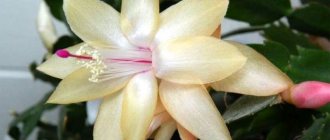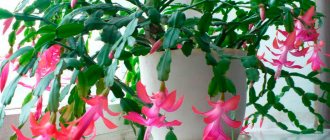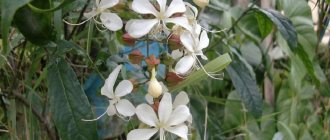Photo of the Schlumbergera flower (Decembrist) - one of the most popular indoor plants. Belongs to the cactus family. It is distinguished by drooping stems and well-growing branches .
There are teeth at the ends. The plant received its name in honor of the French cactus collector Frederic Schlumberger. Although sometimes the flower is also called the Decembrist. Schlumbergera is native to the southeastern region of Brazil.
Decembrist grows up to 40-50 cm in height. Several centimeters are added in one season. The plant lives for several years.
Flowering is one of the reasons for its popularity. Flowers appear at the ends of the shoots. Usually their size is about 2.5 cm. But sometimes large buds appear. Another distinctive feature is the brightness of the flowers.
Also pay attention to the beautiful plants Gymnocalycium and Jatropha.
| Low growth rate. 5-10 cm per year. |
| Blooms in autumn and winter. |
| The plant is easy to grow. |
| Perennial. |
Beneficial features
Schlumbergera.
Photo No beneficial properties of the flower were identified, nor any harmful ones. However, there is an opinion that the plant can still bring some benefits, with the exception of its beautiful appearance.
Flower growers believe that the Decembrist brings positive energy. Some note that in the house in which the plant appeared, the number of quarrels was reduced.
The flower itself also requires dedication from the owners. Schlumbergera loves when people talk to her and when she is praised for flowering.
It is also believed that the flower can ease allergic reactions and relieve insomnia.
Top dressing
In March, the Decembrist begins to grow young shoots, on which beautiful flowers will appear in winter. During this period, the plant is responsive to feeding with any complex fertilizer for indoor plants. In this case, the concentration of drugs should be two times less than indicated in the instructions.
You can feed Schlumberger once a month with liquid fertilizer for cacti and succulents. In summer, fertilizing can be done twice a month. They are stopped in September: the plant cannot be fertilized during the flowering period.
Features of growing at home. Briefly
The main points for caring for Schlumbergera at home are presented in the table.
| Temperature | In summer, room temperature is required - approximately 27℃. In autumn you need a lower temperature - about 10℃. In winter, when flowering begins, an increased temperature will again be needed - about 20℃. |
| Air humidity | Spraying is required regularly, both in summer and winter, if the temperature exceeds 16℃. |
| Lighting | Bright, diffused lighting is needed, especially in winter. It should also be protected from direct exposure to sunlight. |
| Watering | In summer and during flowering, watering should be done frequently; in autumn, the frequency of watering should be reduced. |
| Priming | Requires soil with a lot of humus. It should also be well drained. |
| Feeding and fertilizer | Required during growth. Suitable fertilizer for cacti or flower plants. |
| Transfer | Required every 3 or 4 years. Carried out in early or mid-spring. |
| Reproduction | Propagation by cuttings is easy. |
| Features of cultivation | It is most convenient to grow in hanging baskets. |
Soil selection
Caring for this cactus involves, first of all, choosing the right soil. If you wish, you can always purchase substrate for cacti at any flower shop. If you want to make suitable soil yourself, then you should arm yourself with the following recipe:
- Peat;
- Sand;
- Leaf soil;
- Soddy soil.
All components should be mixed together in equal proportions. Your Christmas cactus will really like it if the soil is heterogeneous - it will contain sections of bark, small pebbles and other additives. It should be noted that the soil must be quite loose. It is necessary to place drainage (small pebbles or special filler) at the bottom of the pot.
Caring for Schlumbergera at home. Details
Schlumbergera flowers rarely appear indoors. To increase the likelihood of flowering, you need to know the details of plant care.
Bloom
It is no coincidence that the Schlumbergera plant received the name Decembrist.
Its flowering occurs just in December. Some species bloom in February. Buds begin to appear in early December . At this time, you cannot disturb the plant - turn it, move it to other rooms. Such actions can lead to the buds falling off.
Also at this time it is necessary to maintain humidity and feed the flower. The room temperature during flowering should be about 20℃.
If the described conditions are provided, you can see bright flowers of different shades. The most common colors are red, white, pink, purple, orange.
Temperature
In winter, the room temperature should not be higher than 20℃. If the temperature is elevated, the plant will not wither, but the buds from which flowers develop may not appear. Another important condition for kidney development is short daylight hours.
Also, temperatures should not be too low. At a temperature of 3-5℃ the plant will die. In summer, the plant will be comfortable at a temperature of 15-20℃.
But the heat should not be constant, otherwise the Decembrist will not bloom at home.
Spraying
To ensure flowering, Schlumbergera must maintain high air humidity.
Spraying should be plentiful and constant, especially in summer. In winter, spraying must be done with caution to prevent frostbite of the flower. The water with which it will be sprayed must be warm. Lack of moisture will cause the buds to drop.
Lighting
A good solution for the location of the Decembrist would be to place it on the windowsills of the eastern and western sides. In these places it will have enough sun, and the likelihood of drying out will be significantly reduced.
to place the Schlumberger over radiators and heaters .
Watering
As for this point on caring for indoor Schlumbergera, the peculiarities of the plant’s origin are taken into account.
In summer and during flowering, regular and abundant watering is required .
The rest of the time it can be reduced to 1 time per week.
Pot
The root system of the plant is poorly developed, because under environmental conditions the flower begins its development near the roots of trees. This means that initially it does not require a large pot. A pot 10 cm high and 6 cm in diameter will be enough.
Priming
Based on the previous point, we can conclude that the Decembrist requires the most loose soil possible. You can prepare it yourself. This will require 1 part peat, 1 part sand and 1 part deciduous or turf soil.
You can make drainage at the bottom of the pot. It must conduct moisture well, because Schlumbergera does not like stagnant water.
Under no circumstances should Decembrist be planted in clay or loam. This soil does not conduct moisture well and limits air access. Other deviations from the described conditions are acceptable, but it must be taken into account that Schlumbergera may not bloom.
Feeding and fertilizer
The flower can also grow in poor soils. But to ensure its beautiful appearance, feeding is required. The plant should be fed no more than 2-3 times a year during flowering and growth.
When purchasing fertilizers, you should pay attention to the composition. If there is nitrogen in the composition, its content should be average. Excess of this substance will lead to rotting of the roots.
Schlumbergera transplant
It is best to transplant while the plant is growing.
When choosing a pot, you need to take into account the need to grow the root system in breadth, not in depth. Therefore, the new pot should be the same depth. The width of the new pot should exceed the width of the previous one by 2-3 cm.
The soil needs good drainage because the roots are more susceptible to rot when replanted.
Young plants are replanted every year, older plants - once every 2 years.
How to trim Schlumbergera
There is an important point regarding pruning Schlumbergera - it is not advisable to cut the plant. It is better to pluck the heavily overgrown parts. Plucking is important because it causes new shoots to appear and new buds to develop from them.
Rest period
This period begins immediately after the plant blooms. During the dormant period, your home Schlumbergera should be kept in a cool place. The desired temperature is 15℃. Decembrist rarely needs to be watered and sprayed. The main thing is to ensure that the soil does not dry out.
Is it possible to leave the plant without care during the holidays?
If you are planning a family vacation, it is advisable to have someone water the plant while the owners are away. It is especially dangerous to leave Schlumbergera without watering in the summer.
How to choose?
The range of exotic flowers offered by flower shops today is simply huge. To avoid disappointment from the purchase, you need to consider a number of points when choosing a Schlumberger.
Appearance. It is necessary to inspect the plant. The presence of brown spots on the shoots, dull coloring of the stems, and wrinkled shoots are a reason to refuse to purchase it.
Health status
It is important to ensure that there are no pests, especially mealybugs. They can be identified by traces of vital activity in the form of white fluffy discharge.
Size of bush, flowers and shoots
Here it is necessary to build on the size of the window sills and the availability of free space in the room. Dwarf varieties with compact crowns take up minimal space. In ampelous (curly) forms, stems with flowers can hang 1 m or more. There are large-flowered varieties, some of which bloom more than once a year.
The purchased specimen must be kept in quarantine for 1-1.5 months and only then placed with other plants.
Propagation of Schlumbergera by cuttings
At first glance, it may seem that it is difficult to propagate Schlumbergera from cuttings. However, it is easier than it seems. To break off the stalk, you need to rotate it around its axis several times. Then the cuttings are dried and planted on moist soil. Their root system begins to develop quickly. At first the new plant will not show any signs of growth. But soon the buds will begin to appear.
There is also another interesting feature of the Decembrist. It can be propagated by grafting onto another plant. To do this, you need to cut off the top of another plant, make a cut on the stem and place a Decembrist cutting there. The junction is tied with thread. It can be removed after the plants grow together.
Transfer
The Decembrist really does not like moving in space and changing soil. In this regard, for a successful transplant, you need to know a few simple rules:
- This procedure is best performed in winter, a month after flowering;
- Handling will significantly increase your chances of successfully replanting the plant. It is better to move the roots along with the old soil;
- Reproduction by roots is not carried out.
- The new soil should not be too wet, otherwise the roots may rot;
- After replanting, the soil must be fertilized and the plant must be sprinkled with clean water;
Diseases and pests
The appearance of diseases in a plant indicates improper care. The following signs indicate an unsuitable environment:
- The buds and flowers of the Decembrist fall off - sudden temperature changes, drafts. Falling off can also happen due to the movement of the plant.
- Schlumbergera does not bloom - in the fall the plant was in conditions with temperatures below 10℃.
- Light spots on the plant indicate excess light.
- It grows slowly , which means it lacks nutrition.
- Wet, watery, or slippery spots indicate a viral or bacterial infection. Infected specimens are almost impossible to save.
- Root rotting indicates overwatering in autumn or winter, or excess fertilizer. In this case, it is better not only to reduce watering, but also to root the plant again.
Some people think that if Schlubmegera is not a very demanding plant, it means that it is not necessary to comply with all care conditions. This is the main mistake gardeners make.
Pests that may appear:
- spider mite;
- scale insect;
- mealybug.
The appearance of pests can lead to the death of the plant.
Overmoistening
Excessively moistened Decembrist, kept in the cold, begins to wither and becomes unstable. Such symptoms indicate the death of the roots. By the way, roots can die not only from hypothermia, but also from heat if the plant is overheated in the sun.
In addition, fertilizer in high concentrations can damage the root system. In this case, the flower must be transplanted into a fresh substrate, after cutting off the roots to healthy areas. If there are few living roots left, it is necessary to thin out the top of the flower, bringing the above-ground part in line with the underground.
Types of Schlumbergera domestica with photos and names
Schlumbergera truncates
The stems of this species diverge from the middle and hang beautifully in different directions. The shoots can reach 40 cm. The segments have sharp teeth on the sides. Schlumbergera truncata flowers come in a wide variety of shades.
There are also several varieties of this species
Bridgeport
This plant is distinguished by its flowers, or rather their color. Plants of this variety are called snow-white Schlumbergera. Most often, the flowers are white and round in shape. Sometimes pinkish flowers are also found.
Cambridge
This variety differs in the color and shape of the flower. At the beginning of flowering, you can see peach buds and blooming flowers. But over time they will turn yellow.
Christmas Charm
The red purple color indicates that it is a Christmas Charm plant. This color is the most common. However, different shades of pink can also be found. This variety of Schlumbergera grows quickly, making it perfect for a hanging pot.
Kris Kringle
The plant also produces bright red flowers. The variety is also distinguished by short segments and compactness.
Lavender doll
This variety, on the contrary, is characterized by long segments. The flowers are large, lavender in color. To get a vertical bush, the plant must be pinched every year.
Peach Parfait
The plant is characterized by vertical growth. Therefore, it is better to place it in a regular pot rather than in a hanging one.
Santa Cruz
This variety is characterized by bright red-orange flowers. It also differs in that the buds begin to take on bright colors early.
Twilight Tangerine
The plant is notable for its light orange or light pink flowers and wide stems.
Landing
Propagation should be carried out after flowering, from April to early summer. The cutting method is used. To implement it, you need to select several young branches and “unscrew” a segment 2-3 segments long. Before planting, you need to dry it until a film appears at the site of the break. This can last from several hours to 1 day. After this, the cutting must be gently immersed in moist soil. It must be in an upright position. To create a greenhouse, you can use a glass jar, but in this case the plant needs to be ventilated sometimes.
Resuscitation methods
There are two main problems that lead to flower wilting:
- Overflow;
- Lack of moisture.
You need to be able to distinguish them from each other, because the approaches to their “treatment” are very different. With insufficient watering, the leaves will lose their tone, become sluggish and wrinkled. The inflorescences dry out. If you “flood” a plant, it begins to lose buds and segments, becomes lethargic and may become covered with brown spots. An indirect symptom may be the appearance of white sediment on the surface of the ground under the plant. The roots are the most vulnerable part of the zygocactus. They are easily damaged and rot due to high humidity. To solve this problem, you need to urgently revive the zygocactus:
- Remove the plant from the affected soil;
- To clean the root system, it must be rinsed under warm running water. Some sources recommend soaking the roots in a weak solution of potassium permanganate;
- It should be replanted in new dry soil and a sterile pot. The second problem can be solved quite quickly and easily - you just need to increase the amount of fluid administered.
Graft
This method of propagating zygocactus is very popular. Schlumbergera is planted with prickly pear or prickly pereskia. First of all, you need to prepare the main plant - a small cut is made in it. The next stage is the preparation of Christmas tree cuttings, which need to be given a wedge shape. It should be inserted into a cut on the host plant. To secure the structure, you can use a needle, thread or plaster. After 2-2.5 weeks, fusion occurs. After this, you can remove all fastening materials. Schlumbergera buckley looks especially striking with this type of reproduction.











